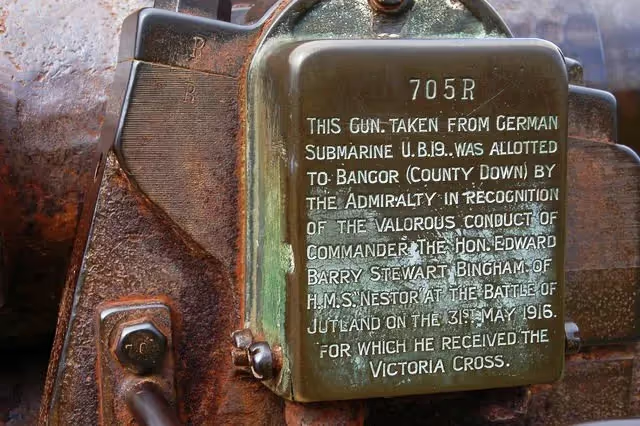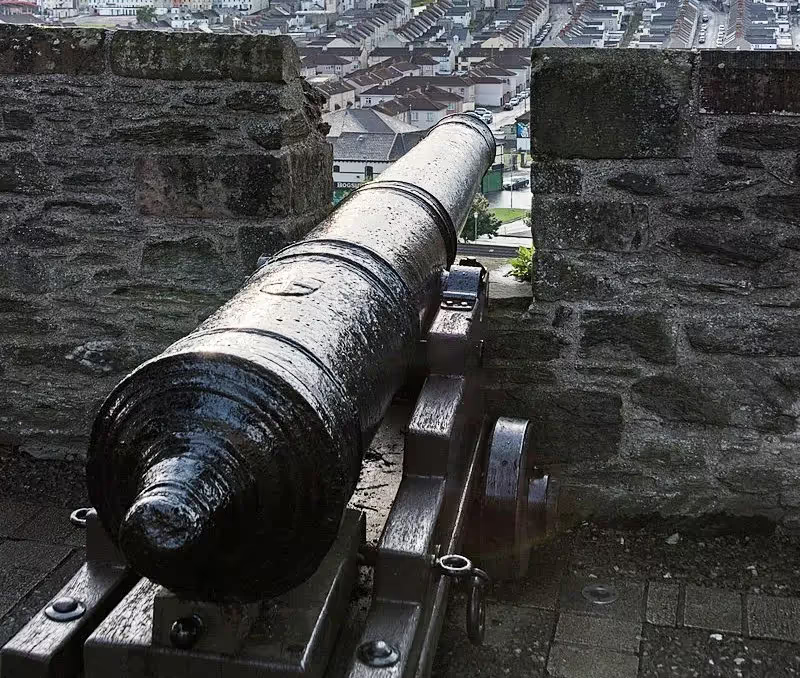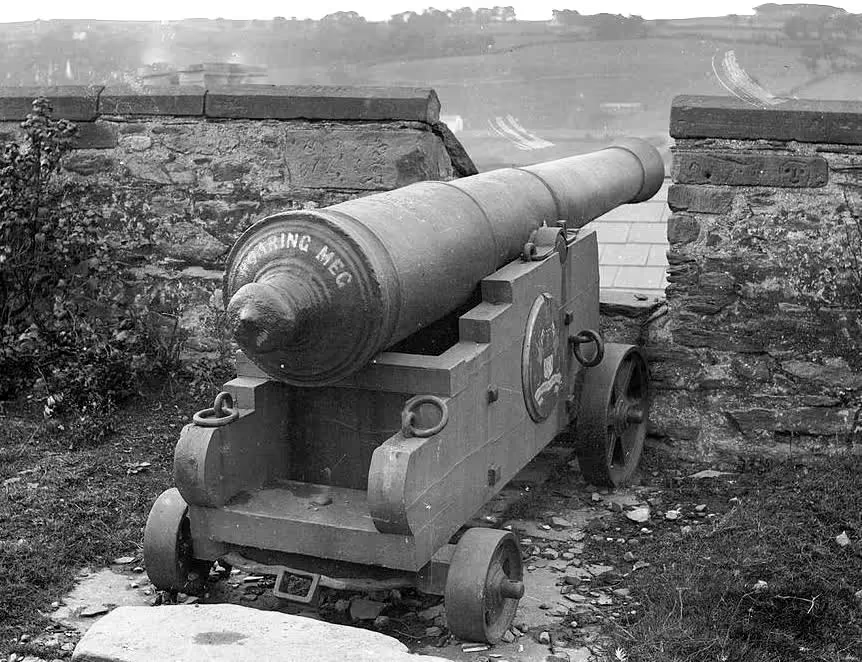Artillery in Ireland: Northern Ireland, Ardglass, Armagh, Bangor, Belfast, Derry, Grey Point Fort, Lisburn, and Newry
Artillery preserved in Northern Ireland:
Ardglass, Armagh, Bangor, Belfast, Derry, Grey Point Fort, Lisburn, and Newry
The aim of this website is to locate, identify and document every historical piece of artillery preserved in Ireland. Many contributors have assisted in the hunt for these guns to provide and update the data found on these web pages. Photos are by the author unless otherwise credited. Any errors found here are by the author, and any additions, corrections or amendments to this list of Guns and Artillery in Ireland would be most welcome and may be e-mailed to the author at [email protected].
Ardglass, County Down, Northern Ireland

(Alan Wright Photo)

(Ardfern Photo)

(Ck234 Photo)
Cast Iron Smoothbore Muzzleloading Gun, at the junction of Quay Street and Kildare Street, Jordan's Castle. This cannon is from a French ship sent to supply guns to the United Irishmen, wrecked off Ardglass.

(Alan Wright Photo)
Cast Iron Smoothbore Muzzleloading gun, mounted on a wooden naval gun carriage, Ardglass Golf Club, Castle Place.

(Ardfern Photo)

(Alan Wright Photo)
Cast Iron 32-pounder 17-cwt Smoothbore Muzzleloading Carronade with a Blomefield pattern breeching ring, mounted on a wooden naval gun carriage, No. 1 of 4, Ardglass Golf Club, Castle Place. The guns have periodically been rearranged in sequence, right to left.
Cast Iron Smoothbore Muzzleloading Gun, mounted on a wood naval gun carriage, No. 2 of 4, Ardglass Golf Club, Castle Place.
Cast Iron Smoothbore Muzzleloading Gun, mounted on a wood naval gun carriage, No. 3 of 4, Ardglass Golf Club, Castle Place.

(Ardglass Golf Club Photo)
Cast Iron Smoothbore Muzzleloading Gun, mounted on a wood naval gun carriage, No. 4 of 4, Ardglass Golf Club, Castle Place.
Armagh, County Armagh, Northern Ireland




(Internet Photos)
Russian Cast Iron 24-pounder Smoothbore Muzzleloading Gun, (Serial No. 907), B:179.30, 1808, on the left trunnion, possibly by Foullon at Alexandrovski, with double-headed Eagle on the barrel, mounted on an iron garrison gun carriage. This gun is a war trophy from the Crimean War, 1854-1855.
Bangor, County Down, Northern Ireland

(Notafly Photo)

(Ross Photo)

(Alan Wright Photo)
Cast Iron possible 2-pounder Smoothbore Muzzleloading Gun, 1780, mounted on a wood naval stand in Ward Park, Bangor Abbey. This cannon taken from the Ulster Privateer 'The Amazon' that was wrecked in Ballyholme Bay on 23 February 1780.
Bangor Abbey was established by Saint Comgall in 558, and was famous for its learning and austere rule.

(BangorArt Photo)


(Aubrey Dale Photo)

(Ross Photo)
German 10.5-cm deck gun, left-side breech end view. This gun was taken from German U-boat U-19 and is located in Bangor`s Ward Park. The gun was used in the Battle of Jutland.
Belfast, Northern Ireland

(Ardfern Photo)
Cast Iron possible 6-pounder Smoothbore Muzzleloading Gun mounted on a wood gun carriage, inside the Ulster Museum, Stranmillis Road.

(Ardfern Photo)
Cast Iron Smoothbore Muzzleloading Gun mounted on a wood gun carriage, inside the Ulster Museum, Stranmillis Road.


(NCDaywalker Photos)
Ordnance QF 25-pounder field gun, located in The Shankill Somme Memorial Park, Belfast, Northern Ireland.
Derry, "Maiden City", Northern Ireland
_p187_VIEW_OF_LONDONDERRY_DURING_THE_SIEGE_OF_1688-89.jpg)
(British Library Image)
View of Londonderry during the siege. The Bishops Gate with its drawbridge is in the centre.
The siege of Derry in 1689 was the first major event in the Williamite War in Ireland. The siege was preceded by an attempt against the town by Jacobite forces on 7 December 1688 that was foiled when 13 apprentices shut the gates. This was an act of rebellion against James II. The second attempt began on 18 April 1689 when James himself appeared before the walls with an Irish army led by Jacobite and French officers. The town was summoned to surrender but refused. The siege began. The besiegers tried to storm the walls, but failed. They then resorted to starving Derry. They raised the siege and left when supply ships broke through to the town. The siege lasted 105 days from 18 April to 1 August 1689. It is commemorated yearly by the Protestant community. (Wikipedia)
Cannon on the walls of the Maiden City
"The cast-iron guns of the Maiden City survived turbulent times. At a most basic level, they are ponderous lumps of cast iron made to wreak death and destruction. But step back a little, and their elegant forms and delicate mouldings contradict the intent of their users. In the wider context of the Atlantic archipelago in the last years of the 16th century and first half of the 17th, they demonstrate accelerating innovation and expertise in the production, manipulation and casting of large volumes of molten iron. In the 18th century, the quest to produce accurate bores gave rise to the technology that underpinned the development of the steam engine, a revolutionary new power source that brought mechanisation on an unprecedented scale. In short, these cannon bear witness to emergent technologies that later would be at the heart of the Industrial Revolution."
"Cast-iron cannon came from an industrial complex spanning the mining of iron ores, construction of charcoal-hungry blast furnaces, and the making of the clay moulds into which the molten metal was poured. The structures of the cast metal observed in this study reveal something of the strengths on which commanders could rely and the weaknesses of which gunners had to be aware of for their lives. But cannon without gunpowder could not fire, and without proper carriages as transport and stable firing platforms, they had no military value. Thus, for cannon to reach ramparts or battlefields required networks of miners, transporters, foundry men, saltpetre producers, sulphur importers, foresters, charcoal burners, clay diggers, blacksmiths, carpenters, wheelwrights, merchants, bankers and financiers, and armies of labourers. They fed a thriving arms trade – both legal and illegal– being produced and sold by some very flamboyant and colourful characters." (Guy Wilson, chairman, ICOMAM, The great guns like thunder: the cannon from the City of DerryB. G. Scott, R. R. Brown, A. G. Leacock and C. J. Salter(Guildhall Hall Press)

(WT-shared, Northern Counties Photo)

(Robert Finlay Photo)
17 Cast Iron Smoothbore Muzzleloading Guns mounted on wood naval carriages guard the city's ancient walls. (Derry is one of 52 walled towns in Ireland). The Siege of Derry (Irish: Léigear Dhoire) lasted from 18 April to 28 July 1689, during the Williamite War in Ireland. The city, a Williamite stronghold, was besieged by a Jacobite army until it was relieved by Royal Navy ships. Several guns manned by the defenders are displayed on different parts of city walls.

(Robert Finlay Photo)
Cast Iron Smoothbore Muzzleloading Gun, No. 1. Elizabethan Rose and Crown cypher, 17th Century.

(Robert Finlay Photo)
Cast Iron Smoothbore Muzzleloading Gun, No. 2. Elizabethan Rose and Crown cypher, 17th Century.


(Robert Finlay Photos)
Cast Iron Smoothbore Muzzleloading Gun, No. 3. Demi-Culverin made by Thomas Johnson, ordered by the earl of Essex in 1598 for Lough Foyle, via Sir Henry Bagenal in Dublin.

(Robert Finlay Photo)
Cast Iron Smoothbore Muzzleloading Gun, No. 4. Arms of the City of London cypher, almost certainly part of a consignment of ten cast-iron cannon sent for the defence of Culmore in 1620.
Cast Iron Smoothbore Muzzleloading Gun, No. 5. Arms of the City of London cypher, almost certainly part of a consignment of ten cast-iron cannon sent for the defence of Culmore in 1620.
Cast Iron Smoothbore Muzzleloading Gun, No. 6. Arms of the City of London cypher, almost certainly part of a consignment of ten cast-iron cannon sent for the defence of Culmore in 1620.
Cast Iron Smoothbore Muzzleloading Gun, No. 7. Arms of the City of London cypher, almost certainly part of a consignment of ten cast-iron cannon sent for the defence of Culmore in 1620.
Cast Iron Smoothbore Muzzleloading Gun, No. 8. Arms of the City of London cypher, almost certainly part of a consignment of ten cast-iron cannon sent for the defence of Culmore in 1620.

(Robert Finlay Photo)

(Giorgio Galeotti Photo)
Cast Iron Smoothbore Muzzleloading Gun, No. 9. Demi-Culverin, Vintners of London cypher.
Cast Iron Smoothbore Muzzleloading Gun, No. 10. Demi-Culverin, Salters of London cypher.
Cast Iron Smoothbore Muzzleloading Gun, No. 11. Demi-Culverin, Fishmongers of London cypher.
Cast Iron Smoothbore Muzzleloading Gun, No. 12. Demi-Culverin, Mercers of London cypher.
Cast Iron Smoothbore Muzzleloading Gun, No. 13. Demi-Culverin, Grocers of London cypher.
Cast Iron Smoothbore Muzzleloading Gun, No. 14. Demi-Culverin, Merchant Taylors of London cypher.
Cast Iron Smoothbore Muzzleloading Gun, No. 15. Demi-Culverin, Merchant Taylors of London cypher.




(Robert Finlay Photos)

(SeanMack Photo)

(Nicholas Raymond Photo)
Cast Iron 6-pounder Smoothbore Muzzleloading Gun, No. 16. Produced between c. 1773 and 1796 by John Wilkinson at Bersham, North Wales.

(Gav Connolly Photo)

(Romeparis Photo)
Cast Iron 6-pounder Smoothbore Muzzleloading Gun, No. 17. Produced between c. 1773 and 1796 by John Wilkinson at Bersham, North Wales.

(National Library of Ireland Photo)
"Roaring Meg", named because of its ferocious sound in battle, was used during the Siege of Derry. One account of the famous cannon from the time of the Siege in the 17h Century said: "The noise of its discharge was more terrifying than the contents of the charge to the enemy." The barrel of the cannon bears the inscription "Fishmongers London 1642", marking the fact that it was one of 24 cannon sent to Derry by the City of London and the London Companies after the 1641 siege.
Fishmongers bought the demi-culverin "ready-made" so to speak from Samuel Ferrers, John Browne the gunfounder's London agent; he kept a store/warehouse and most of the Livery Companies bought their guns there for the plantation. Later the Fishmongers added a carriage and ammunition to their contribution. The records are quite clear it is a "demyculveryng"; most of the guns sent by the London livery companies in 1642 were all demi-culverins.
“Roaring Meg” is the most famous of the city of Londonderry’s collection of cannon. Part of a consignment sent from England in 1642 for the defence of the city after the outbreak of the 1641 Irish Rebellion, her purchas financed by the London Fishmongers Guild. She is a demi-culverin of 10 feet weighing in at 3955lb (1795kg) with a bore of 4.7 inches delivering a ball of maybe 15lb. The tube architecture is three stepped fields divided by two broad mouldings and a nicely flared muzzle. There are no markings on the trunnion faces but the first reinforce is marked “ Fishmongers London 1642”

(Alan Wright Photo)
Russian Cast Iron 24-pounder Smoothbore Muzzleloading Gun, a Crimean War Trophy mounted on an iron garrison carriage. This gun was captured at Sebastopol and installed in Derry City on 2 Jan 1860. Derry to have the most cannon of any European city.
Grey Point Fort, Helens Bay, County Down, Northern Ireland

(Nick Photo)
Ordnance QF 25-pounder field gun.

(Nick Photo)
Breechloading 6-inch Mk. VII Gun on a Mk. II(L) CP Garrison Mounting No. 1 and No. 2 of 2, Crawfordsburn County Park.
Lisburn, County Antrim, Northern Ireland


(Notafly Photos)

(Pieces of History Photo)


(Ardfern Photos)
Russian Cast Iron 24-pounder Smoothbore Muzzleloading Gun, a Crimean War Trophy mounted on an iron garrison carriage. This gun was captured at Sebastopol and presented to the city in 1858. It is on display in the Castle gardens, Castle Street.
Newry, County Down, Northern Ireland






(Robert Finlay Photos)

(Ardfern Photo)
Russian Cast Iron 24-pounder Smoothbore Muzzleloading Gun, (possibly Serial No. 135624, corroded) on the left trunnion, possibly by Foullon at Alexandrovski, with double-headed Eagle on the barrel, mounted on an iron garrison gun carriage. This gun is a war trophy from the Crimean War, 1854-1855. Armagh Down Bridge, Bank Parade.

(Alan Wright Photo)
Cast Iron possible 12-pounder Smoothbore Muzzleloading Gun on a wood stand, roadside marker, A2 Newry to Warrenpoint Road.





